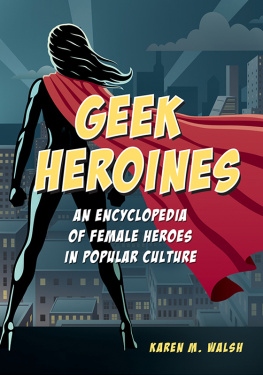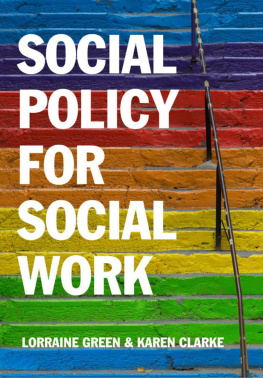First published 2013 by Westview Press
Published 2018 by Routledge
711 Third Avenue, New York, NY 10017, USA
2 Park Square, Milton Park, Abingdon, Oxon OX14 4RN
Routledge is an imprint of the Taylor & Francis Group, an informa business
Copyright 2013 by Karen Sternheimer
All rights reserved. No part of this book may be reprinted or reproduced or utilised in any form or by any electronic, mechanical, or other means, now known or hereafter invented, including photocopying and recording, or in any information storage or retrieval system, without permission in writing from the publishers.
Notice:
Product or corporate names may be trademarks or registered trademarks, and are used only for identification and explanation without intent to infringe.
Every effort has been made to secure required permissions for all text, images, maps, and other art reprinted in this volume.
Library of Congress Cataloging-in-Publication Data
Sternheimer, Karen.
Connecting social problems and popular culture : why media is not the answer / Karen Sternheimer. 2nd ed.
p. cm.
Includes bibliographical references and index.
ISBN 978-0-8133-4723-3 (pbk. : alk. paper)ISBN 978-0-8133-4724-0 (e-book) 1. Mass mediaMoral and ethical aspectsUnited States. 2. Popular cultureMoral and ethical aspectsUnited States. 3. Mass media and cultureUnited States. 4. Social problemsUnited States. I. Title.
HN90.M3S75 2013
302.2301dc23
2012034416
ISBN 13: 978-0-8133-4723-3 (pbk)
Rather than viewing popular culture as guilty or innocent, the central theme running through Connecting Social Problems and Popular Culture is that various media and the popular culture they promote and produce are reflections of deeper structural conditionssuch as poverty, racism, sexism, and homophobiaand economic disparities woven into major social institutions. While discussions of sexism in various forms of media, for instance, are often lively and provocative, the representations themselves are not the core reason that gender inequality continues to exist. Media images bring it to our attention and may further normalize sexism for us, but our examination of our society should not end with media.
In order to understand social problems, we need to look beyond media as a prime causal factor. Media may be a good entry point for thinking about how social problems have a basis beyond the sole individual. But while that premise can open the discussion, this book aims to help students and other readers take the next step in understanding social problems. We must look deeper than popular culturewe need to look at the structural roots to understand issues such as bullying, violence, suicide, teen sex and pregnancy, divorce, substance use, materialism, and educational failure.
Neither media nor popular culture stands still for very longmaking the study of both a never-ending endeavor. In this second edition of Connecting Social Problems and Popular Culture, I include a new chapter on fears about social networking and electronic harassment. With concerns about bullying and sexting leading to suicide after news accounts of high-profile cases, it is important to uncover what we know about the role that new media play in such incidents. Perhaps not surprisingly, social networking is less of a culprit than an attention getter. Additionally, each chapter has been updated to incorporate, where applicable, new research and trend data on crime, pregnancy, birth- and divorce rates, substance use, and other social issues for which popular culture is so often blamed.
The link between video games and actual violence is always a topic of interest for readers and lay theorists of social problems. In 2011 the US Supreme Court upheld a lower courts ruling that states cannot limit the purchase of violent video games. In handing down this major decision, the Supreme Court decided that California had not proven how actual harm came from playing video games. I address this ruling in greater detail in on media and violence.
Because popular culture is so ubiquitousand, frankly, funit is a great window for students in a variety of courses to look through as they begin exploring social issues. Students in introductory sociology and media studies courses and social problems and social issues classes, as well as those studying inequality, will be able to make connections between the material and the many common beliefs about medias effects on society that this book addresses.
By challenging the conventional wisdom about what the media does to its consumersespecially those considered less capable than their criticsreaders can begin to think critically about the ways in which social issues are framed and how sensationalized news accounts help shape our thinking about the causes of societal problems. Beyond simply debunking common beliefs, this second edition stresses the importance of social structure and provides an introduction to structural explanations for the issues commonly blamed on popular culture. By digging deeper beyond simple cultural arguments, readers learn how policy decisions and economic shifts are important explanatory factors for many issues blamed on media.
Each chapter begins with examples from pop culture that many readers will already be familiar with, taken from celebrity gossip and controversial television shows like Teen Mom, high-profile news stories, and other easily accessible accounts. Additionally, each chapter introduces findings from recent research, often breaking down the components of the sampling and methods for readers to better understand how research is conducted and how to think critically about the results presented in the press. Where applicable, each chapter includes supporting dataand in some cases graphsfrom federal sources, such as the census, Federal Bureau of Investigation, and Centers for Disease Control and Prevention, to provide evidence of longterm trends, often challenging misperceptions about particular issues. Because these sources are easily accessed online (and URLs are included in notes at the end of chapters), readers can learn to spot-check popular claims about these issues on their own in the future.
The evolution of this book, across its editions, has truly been a team effort. Thanks to Alex Masulis, my first editor at Westview Press, to Evan Carver who, early on, championed the second edition, and to Leanne Silverman, who helped bring the book in your hands to print.
I am also very thankful for my student researchers who helped find articles for this book. William Rice, Jessica Sackman, and Mishirika Scott assisted with the first edition, and Kimberly Blears helped with the revised edition. They and many other undergraduate students at the University of Southern California have been a pleasure to work with; their input in my classes helps keep me grounded in youth culture as time takes me further away from being anywhere near pop cultures cutting edge. Several anonymous reviewers provided useful comments and suggestions, and I thank them for helping make this book stronger. For their helpful criticisms and invaluable suggestions, I also want to thank David Briscoe, Joshua Gamson, Kelly James, Marcia Maurycy, Janet McMullen, and Markella Rutherford.











